Intense light fell from a vaulted powder-blue sky that offered here and there a cloud so fat and dense-looking, it might have been full of milk. A monied seafront gleamed as much as the ocean. The coastline was lined with an assortment of majestic marine figurines, spotless sidewalks and restaurants with menus on which we couldn’t afford to dine. La Paz reeked of money but didn’t seem unwelcoming although to be fair, there was hardly a soul about. “Oh my gawd, Lisa!” Jason uttered, disbelievingly. “What?” I barked eagerly back. “There’s an osprey! Up there, sat on top of that lamp post.” And so it was, a yellow-eyed raptor known as the sea hawk ready to hunt over the water. Welcome to off-peak Baja California.

The sparkling seafront off La Paz, Baja California
Without asking, proprietors Cindy and her husband at Campestre Maranatha bestowed us with a spacious air-conditioned cabina for the cost to camp in our pegged hothouse. Don’t you just love low season? The air was silvered, imbued with a steady, shadowless, all but sourceless light that could as easily have emanated from the desert floor as from the atmosphere. The warm wet drip of the jungle was gone. Long gone. At the front of the sun-scorched premises, we found Café Exquisito: a delightful little eatery adorned in teapot chic, offering a divine selection of freshly baked goodies to boot. As a stopover place, we’d found our utopia.
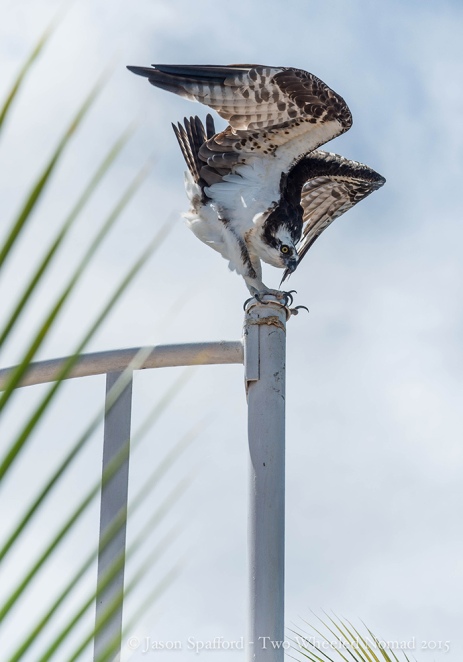
Just look at that osprey!
By dusk, six wheel trucks continued to blast past kicking up a knee-high fury of sparkling dust each time. The rays of light streaking through the low clouds that night shimmered in colours of pink and purple, rose and violet—the very light seemed to have burst into a halo of heavens. It was about the only time people no longer had to hide from the peninsula’s skirmishing heat. Over the sound of my breath I could hear the dry nocturnal rumble of the desert, a dim racket of dust and wind.
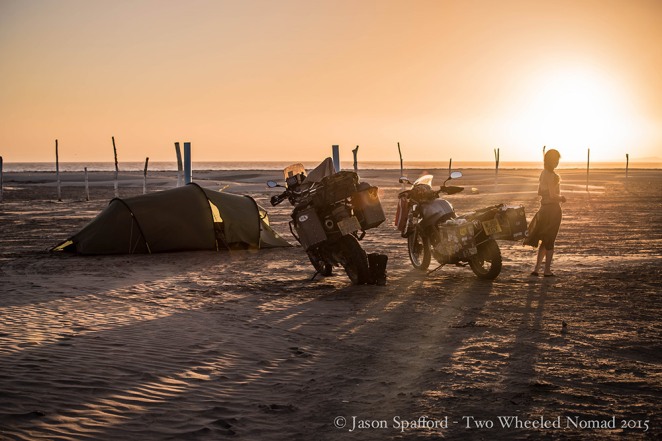
Stunning sunset on the Baja
Hungry for a burrito-sized bite of the Baja’s southern slither, we meandered down to Cabo Pulmo—a small village on the shores of the Sea of Cortez. Laced in a smattering of sand for the last handful of miles, the dirt road got me back into the swing of things—riding Pearl through unpaved pleasure home to a kaleidoscope of living confetti—butterflies, fluttering like flowers of the air.
An increase in the heat triggered a change of heart in Jason post temperatures too ludicrous in which to think, let alone sleep. Making a sharp exit from the sun-bleached shores of Cabo Pulmo, we roared back up the road at full tilt and kicked the side stands down in La Paz the same day. And where was the dry heat that I’d had my heart set on for so long? The pair of us was leaking puddles of sweat on every seat, saddle and sidewalk. Yak.
Ribbons upon ribbons of northbound Tarmac became our security blanket amid the boundless voids of parched desert. Barren beyond belief and the human eye, I wondered just how frightening it’d feel to be trapped inside the hairdryer heat, on bone-dry scrubland and seared sand.
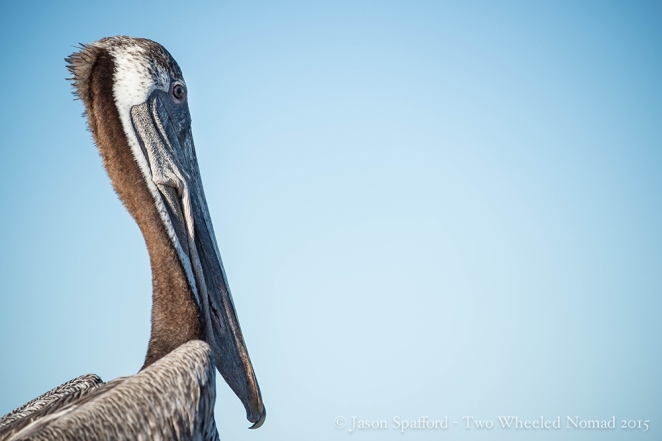
Pelican on the waters off Loreto
As the oldest permanent settlement on the Baja and former capital, Loreto sold itself as a charming little spot made pretty by the pelicans, other dive-bombing birdlife and the boat-bobbing marina. With friends away on a road trip, we meandered right through their sleepy town of Mulegé, momentarily enjoying its kick-back feel but didn’t stop until reaching Santa Rosalia, just a bit farther on.

Peeking at a pair of pelicans
A fairly unique Baja town with a personality different to the average seaside towns. Once dependent on a large copper mine that remains a highly visible part of Santa Rosalia, the place is also home to a French bakery, Panadería El Boleo and the Iglesia Santa Barbara de Santa Rosalía church, famous for its designer—Mr Alexandre Gustave Eiffel Tower himself. Although not one of those three are set to surface on my radar when I reminisce about the spot.
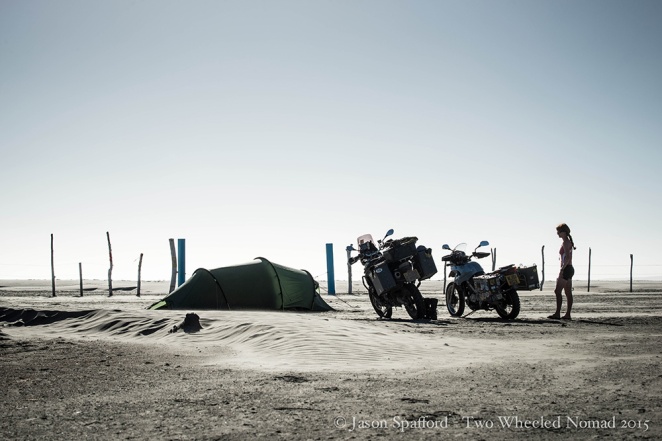
Beach camping is a must on the Baja
I glanced up at the deep lavender that was fading into darkness, the few puffs of clouds above Santa Rosalia darkening, purpling into a bruised colour. Unfamiliar insects produced a soft but insistent chirp; a crisp whir like the sound the earth itself might make rolling through the darkness if we all kept quiet enough to hear it. Dog barks rent the air as they called to each other. Despite the natural noises humming in the background, there was a surreal silence, free from urbanisation; it put me in a state of hyper-awareness, when you notice the weight of your eyelids blinking. We became embodiments of gentleness.
Beneath an almost cloudless and comfortable evening the lights of the town shone. They were not far away. Still, they looked almost too real and close to touch. They were like holes punched in the night, leaking light from another in a more animated world. Beneath a star-spangled nighttime sky, I looked up and saw a full moon, blood-orange and socketed in a gas-blue sky, which was in fact eyeballing us. It’s not often you’re privy to a lunar eclipse where the planet is perfectly aligned between the sun and the moon.

The lunar eclipse above Santa Rosalia
Guerrero Negro doesn’t look the kind of place that’d appear on anyone’s “Top ten” of the bucket list. Not when you ride through the dusty wind and through gritty eyes see the salt works, tens of fish taco stands and flat featureless landscape. However, there was a plethora of power lines adorned with purpose built mounts for osprey nests, and from January to April grey whales come into the lagoon from their 6,000 mile migration to give birth. I saw neither osprey chicks nor grey whale calves but on the upside, Tony’s shrimp tacos were exceedingly good on the tastebuds.
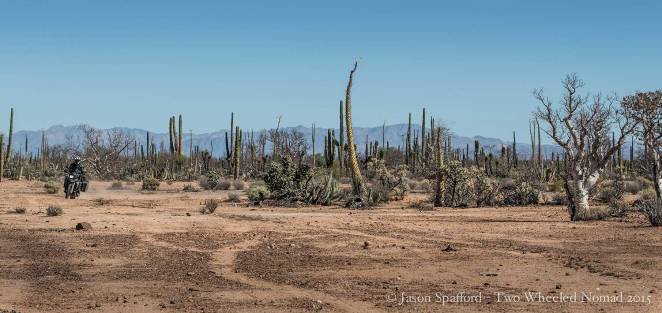
Baja: the cactus garden of Mexico
Less than enthralling towns aside, the Baja Peninsula is the cactus garden of Mexico. Bushy opuntias including the prickly pears, Indian figs and chollas are just some of the beautifully named species. Wherever you go, so do the cacti. In fact, they don’t care if you’re a long distance motorcycle overlander or holiday tourist, they’ll be following you.
And how exactly can a cactus stalk and walk? On the Magdalena plain, we were treated to an array of the creeping devil cactus; a plant highly adept to slowly migrating over the desert ground and incredibly, can even climb over obstacles. Over 1,000 species of cacti exist in northern Mexico alone, quite prolifically, and about half of those are endemic.

Fred Flintstoneville
The Valle De Los Cirios Natural Protected Area—a sparsely populated 200 kilometre long wild costal region—gave us perhaps the best sightings of the drought-loving masters of the desert. Whether columnar-like looming organ pipes or spherical and spiky, ribbed or smooth, they will suck every last drop from the desert in order to dominate and survive. I can’t think of anything else better adapted to one of the drier places on the planet.

Ribbed organ pipes pillaging every last drop of water
Some of the wandering sprouts flower in white, yellow, red and lilac blossoms, others yield succulent green or raspberry red fruits (known as tuna), from which sweet preserves and syrups can be harvested. They make a marvellous material for burning as a fuel, building fences and enclosures of pasture-grounds. Not to mention a food source for the local fauna and bird life, medicinal benefits if you need your blood pressure raising and cosmetic invigoration to the skin. Who knew cacti was so underrated?

Boojum trees: about the strangest trees we’ve ever seen
The cactus-abundant ground we stopped on was uncanny as a Fred Flintstone inspired movie set, spouting all over the place with the spiky starburst of the cardon. Splayed like spaghetti around a big bedrock of boulders, the Boojum trees were akin to inverted hairy carrots but that’s the Baja and its unique Sonoran desert flora for you. Engulfing us, also stood the elephant trees overlooking the flat-topped rocky headlands featuring a succession of Table Mountains straight out of Cape Town but on a smaller scale, which brightened as they rose toward the sky. For me, it was quintessential as native Mexico gets.

Great survival strategy, boys
Ensenada was our final taste of Mexico on the Baja, just 80 miles south of Tecate adjoining the US border. Passing through wine country on both sides to get there, it’s a port city blended by the usual suspects: tourism, fishing, shipyards, agriculture and ranching. Although we opted out having had a nigh on two-year fill of colonial cities. Pitching up at a spot on the water along a pretty stretch of Pacific coastline bestowed a crisp evening breeze for both nights, the company of a cute but feisty kitten where we and our tent became her play-things the entire time, and over-the-road access to the tastiest tamales: leaf wrapped steamed corn filled with anything from pineapple to pork. Nom!
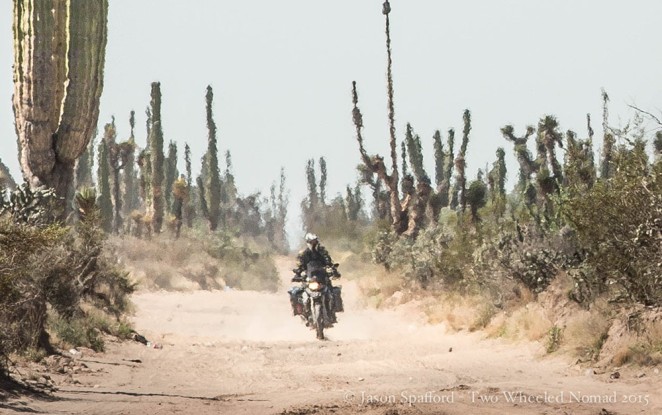
Jason shimmering in the heat haze
And that concluded our final taste of Latin America. México: where the limes are known as limóns and the lemons are known as limas. Where bread is baked to match the taste and texture of flaky cake, and just about everything is over-sweetened to the point of genuinely fearing for one’s enamel. Including the milk. When food is not purposely served red, white and green in a true patriotic style, it’s made of corn: pulque, a fermented pre-Hispanic drink prepared from corn; huitlacoche is a fungus that grows on corn and I’d argue what might seen as insignificant by other countries, is a delicacy by the Mexicans; and elote, which is ice cream made from—you guessed it—corn! Seriously, you’ve got to respect those serial lovers of the cereal.
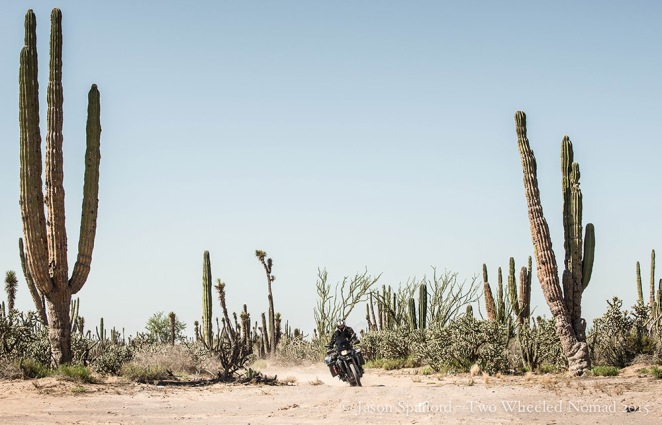
Cranking it over in the sand…show off!
The logic behind the country’s mentality is a little ‘out there’. The local vendors of street-side food served us meals on plastic bag covered plastic plates (saves on the washing up but not so much on landfill). There were also these big ball bearings, like myriad half moons of malevolence, polished to a high shine poking up through the concrete and casting their beady eye on the next unsuspecting motorcycle wheel. Granted, they perform admirably and slow you down, but lapse in concentration for a second over those things, and they’ll likely fetch you off. They were even more repugnant in the rain.

Getting lost in the desert
Questionable judgment and the quirky reasoning of a developing country aside, fireworks are considered to be man’s highest form of artistic expression, just a notch above the sombrero-topped Mariachis, strolling down the street while strumming their guitars and blowing down their trumpets. It’s a land that almost permanently booms through the storm of sound, rolling over the rural hills as much as the towns’ topes (speed bumps). I swear there is one per capita.
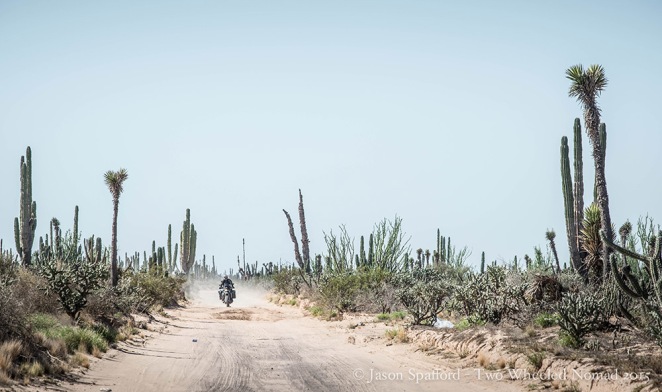
Eat my dust, darlin’!
Mexico is a country of many faces. Look on the fringes of most colonial towns and you’re likely to see hill after hill adorned with Lego houses in a rainbow of Latino colours. Guaranteed you’ll also be gawping up at a clear Mexico night more oft than not, crazy with stars. I could barely believe my lucky stars when we experienced a lunar eclipse in Santa Rosalia on top.
Lush jungle one minute, nippy-on-the-knickerbocker-glory atop the mountains the next, it’s undeniably vast, varied and vista-fantastic in places. The desert proves to have its own wild beauty, perhaps my favourite blend: its odd mix of emptiness and moment and its searing, bottomless sky. When the tent zipper opens, beyond it lies a stark, desolate landscape in which an unprotected traveller would not last so much as a single day.
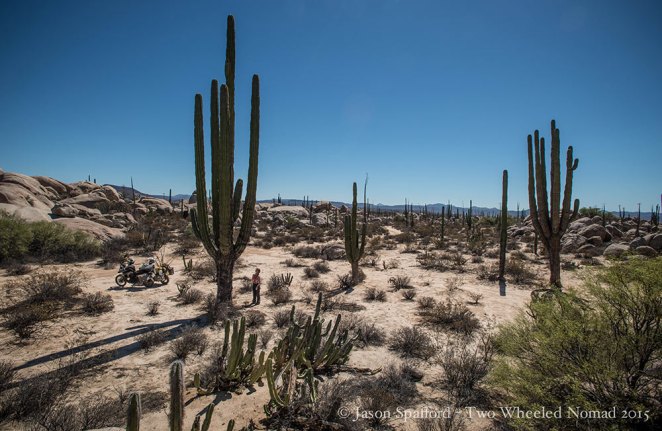
For me, this is quintessential native Mexico!

Hey guys – quality as ever and great moonshot! Best one I’ve seen! Glen and I Will be a mere 3 time zones away tomorrow -we fly to Fort Myers to start our 23 day harleyfest – no idea yet where we are going but will be hard to resist the pull of 66 and maybe start ourselves a new gold rush . Luv to you both who knows maybe we’ll be sharing some tarmac at some stage !!! Ian
Sent from Samsung tablet
LikeLiked by 1 person
Hi mate – great to hear from you, have a fab time during your Harley-fest. We’ll keep our fingers crossed that we’ll get to ride together. See you soon, L&J x
LikeLike
I’m jealous, never been to Baja!
LikeLike
Never say never…L
LikeLike
Between Jason’s incredible pictures and your beautiful storytelling you really manage to make us experience the emotions of the journey.
After a day of back to back meetings, it is a wonderful way to remind myself that there’s a lot more to life. Thanks!
LikeLiked by 1 person
No thank you, you’re welcome! L&J
LikeLike
I couldn’t tell the difference between an osprey and an ocelot. Well, I probably could because they’re different species. But I wouldn’t know an osprey if it pecked me on the head. Hat tip to Jason for being able to recognise one. Must love his birds. :o)
Mesmerising writing as usual. I got lost on “myriad balls of malevolence poking up through the concrete” though. What were these? Half-buried cannonballs? Sauron’s fingertips? Ball bearings?
And the harshness of the deserts! I like researching wilderness survival and was imagining being stuck or lost in that desolation. What preparations did you take before crossing large stretches of desert?
Take care guys!
LikeLiked by 1 person
Hi Mario! You’re right, Jase adores birdlife and has done since he was a kid.
Think ball bearings, metal bumps–caught me out almost every time!
Desert prep: just water and simple meals is all. Cheers L&J
LikeLike
Really enjoyed your take on the Baja. A special place where nature is crazy and harsh and pushes back! I have fond memories of some 2 wheeled exploration to old missions.
Hope you have a place in the south to wait out winter! Most norte americano’s would be heading the other way!! Buen suerte, Vic
LikeLiked by 1 person
Thanks Vic, despite the stupid temperatures, we still had fun on the Baja…pretty special in places. Coolest cactus trees I’ve ever seen, and amazing that there’s over 1,000 species of them. Yowsers. L
LikeLike